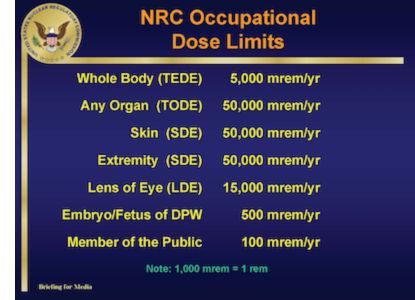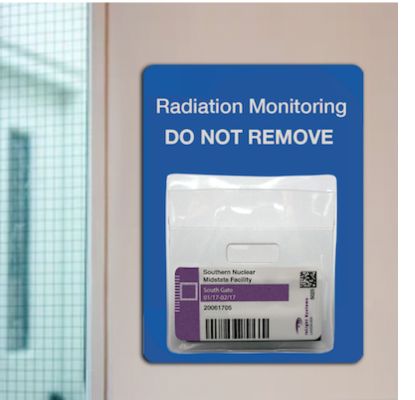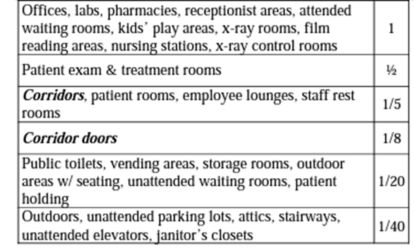
Beyond Your Employees: Radiation Dose Limits for the Public
A common assumption in facilities using ionizing radiation sources is that the existing shielding and/or the distance to occupied areas are in compliance with state and federal regulations for radiation dose limits for the public. But that may not be the case. Some things to consider…
- Do you or your facility’s engineers have copies of the original and any subsequent shielding evaluation reports?
- Have the sources of ionizing radiation in your facility changed over time?
- Has the workload (e.g., the number of procedures) increased?
If you want to know if you are within the radiation dose limits for the public, some simple calculations and measurements in public areas are required.
Radiation Dose Limits for the Public are Different Than for Your Radiation Workers
To understand what Public Dose is, we first need to understand that it is not occupational exposure (i.e., radiation received by employees from sources under the control of the employer). There are groups of individuals who infrequently work with sources of radiation and ancillary employees who visit areas where sources of radiation are used or stored. These people are not considered “public.”
If, in the course of an employee’s assigned duties, they are exposed to sources of ionizing radiation, they are radiation workers. Even if their exposure is minimal, personal monitoring is required if the Individual Responsible for Radiation Protection (IRRP) or the Radiation Safety Officer (RSO) determines that employees have a reasonable potential to exceed 5 millisieverts (500 mrem) per year. The IRRP or the RSO will determine their status and whether personal monitoring is appropriate per state and Federal law.
What are the Radiation Dose Limits for the Public?
The Environmental Protection Agency states in Federal Guidance Report No. 14-2014 – Radiation Protection Guidance for Diagnostic and Interventional X-ray Procedures “The effective dose to an individual member of the public should not exceed 1 mSv (100 mrem) in a year from occupancy in unrestricted areas in or near medical radiation facilities.”
 This is consistent with NCRP guidelines (NCRP 2004a). In health care facilities, all non-radiation workers (e.g., janitorial staff, secretaries) should be afforded protection consistent with that afforded members of the public. This is relevant to the design of radiation shielding, which considers occupancy factors.
This is consistent with NCRP guidelines (NCRP 2004a). In health care facilities, all non-radiation workers (e.g., janitorial staff, secretaries) should be afforded protection consistent with that afforded members of the public. This is relevant to the design of radiation shielding, which considers occupancy factors.
Remember that an occupational dose is received in the course of an employee’s assigned duties. It does not depend on the location where the dose is received (restricted, controlled, or unrestricted). The Nuclear Regulatory Commission (or equivalent “Agreement State” regulations) requires licensees/permit holders to demonstrate that members of the public are unlikely to receive a dose exceeding 1 mSv (100 mrem) per year.
State regulators have similar or more stringent requirements for machine-produced radiation sources (e.g., post-installation area surveys and area surveys after repairs which might affect output). Employers can demonstrate that the public dose is unlikely to exceed this limit by reviewing dose histories for radiation workers in specific work areas, reviewing area radiation surveys or area dosimeter results, or estimating the public dose from source strength, distance, occupancy, and shielding data.
Using Area Monitors to Ensure Radiation Dose Limits for the Public are in Compliance
The public dose can also be measured using Area Dosimeters. The use of area dosimeters is an easy, inexpensive way to assess the adequacy of shielding materials and public dose.
Area Dosimeter results need to be corrected for distance and occupancy. Dosimeters are mounted on surfaces and people are assumed to be at least 30 cm (12 inches) from the surface. Additionally, the same member of the public is unlikely to occupy the area opposite your ionizing radiation source for extended periods.
Where to place area monitors
 Based on knowledge of ionizing radiation source locations, the RSO or designated radiation safety manager will determine the areas to be monitored.
Based on knowledge of ionizing radiation source locations, the RSO or designated radiation safety manager will determine the areas to be monitored.
You first need to assess the pathways for public radiation exposure. Ask your facility engineers or management to provide you with a copy of the architectural plans (i.e., the Design Plan/Shielding Review) as this will illustrate areas that do not need to be monitored. Remember to obtain plans for areas above and below, as floors and ceilings are radiation barriers that may be occupied.
Consider placing dosimeters in areas that the public can access:
- Where the adequacy of radiation shielding cannot be demonstrated
- Adjacent to High-Radiation Areas
- Where radioactive materials are received (loading dock, pharmacy, mail room, etc.)
- Adjacent to radioactive materials use and storage areas
- Adjacent to radioactive waste or decay in storage areas
Facilities using radioactive materials also need to consider the emission of radioactive volatiles/gases and the disposal of radioactive material via the sanitary sewer as pathways for public radiation exposure. Regulatory requirements and acceptable methods for demonstrating compliance can be found in Title 10, Code of Federal Regulations, Parts 20.1101(d) and 2003 or the equivalent Agreement State regulations.
How to place area monitors
Depending on the surface and the presence of shielding, you may need to be creative when attaching dosimeters to walls. Consider mounting the dosimeters to a sign warning the public not to move or tamper with the dosimeters as shown in the image at the right. Dosimeters look interesting and potentially valuable and you don’t want passing visitors (e.g., children) to move or take them.
Tape and glue are discouraged in the healthcare setting because they can become a source of bacterial growth. However, I have found hook-and-loop strips to be an effective means to secure the warning signs to a wide variety of surfaces. I prefer hook-and-loop strips over cup hooks or nails because no penetrations are needed in potentially shielded walls.
Dosimeters should be placed at chest height (4 feet) facing the radiation source. In a multi-story facility, you may need to place them on the floor above or the ceiling below and correct the results for distance.
Estimating annual dose
 If you don’t plan to monitor continuously or for a year, ensure you obtain representative measurements. If your workload changes significantly during the year, measure during the periods of greatest use. At least six months of data is preferred.
If you don’t plan to monitor continuously or for a year, ensure you obtain representative measurements. If your workload changes significantly during the year, measure during the periods of greatest use. At least six months of data is preferred.
The dose results from six months can be multiplied by two to obtain an annual dose estimate. Then, correct the result for occupancy and distance using the inverse-square formula. Consider how often the public area is occupied by a unique individual and then adjust your dose estimate.
The National Council on Radiation Protection and Measurements (NCRP) Report 147 has suggested occupancy factors that can be used in a healthcare setting (see chart to the right). If you have more accurate occupancy data, use it!
Who Enforces the Radiation Dose Limits for the Public?
The Environmental Protection Agency (EPA), the Joint Commission, states, and other accreditation agencies regulate and advise employers and employees about patient/public safety (e.g., occupational dose limits, public dose limits, and maintaining radiation dose As Low As Reasonably Achievable or ALARA).
Note: OSHA does not regulate public dose.

